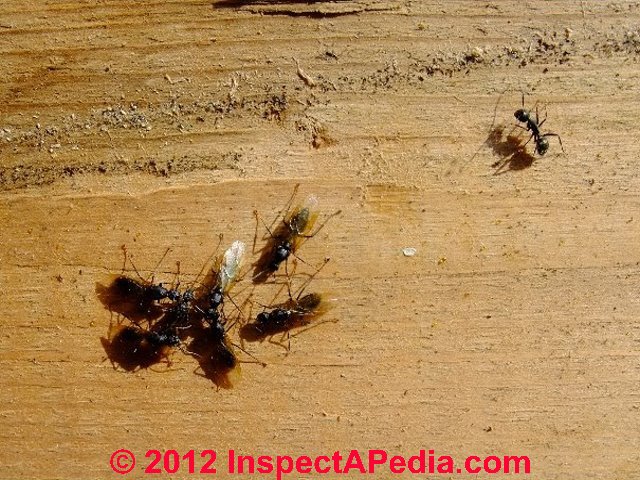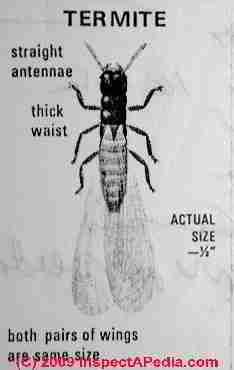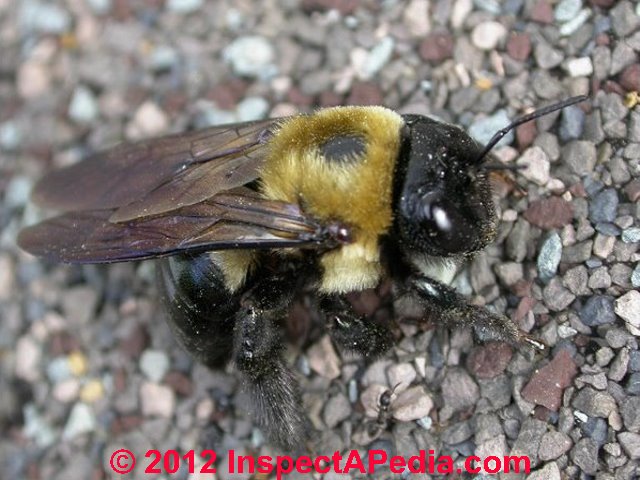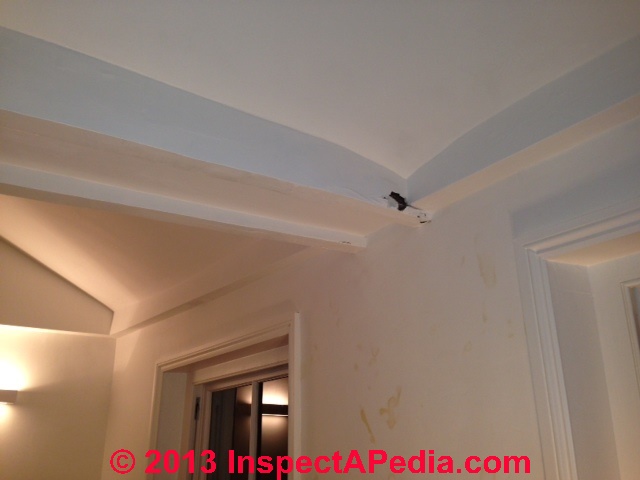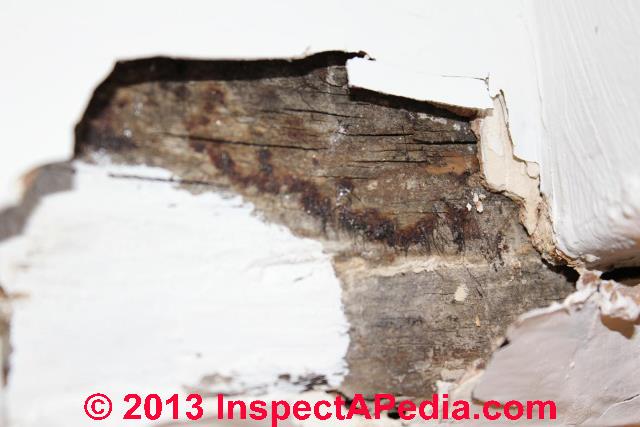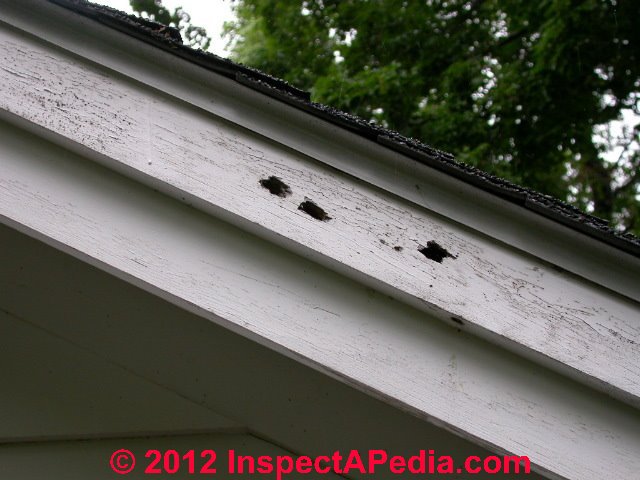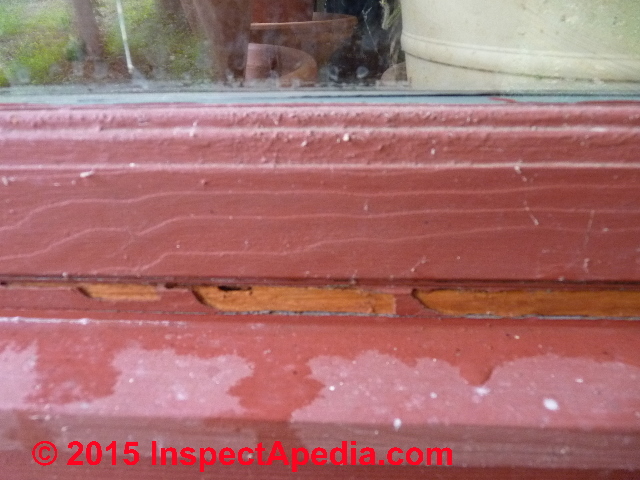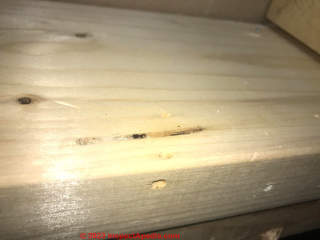 Insect Identification, Infestation & Damage in Buildings
Insect Identification, Infestation & Damage in Buildings
Recognition, assessment, & repair of structural damage
- POST a QUESTION or COMMENT about the recognition, cause, & prevention of rot, fungus, mold or insect damage in buildings
Rot, mold, or insect damage in buildings:
How do we distinguish among these types of infestation & damage on or in buildings? How do we distinguish between carpenter ants and termites, how do we identify carpenter ant damage, carpenter bee damage, powder post beetle or old house borer damage and termite damage.
What building construction details increase the risk of insect damage, and how do we evaluate the extent of structural impact of existing insect damage on a building.
Preventing damage by wood destroying insects (termites, carpenter ants, powder post beetles) by good design and by building maintenance is preferred to simple chemical applications around a property. When use of pesticides is required, there are some important choices.
Page top photo: powder post beetle damage in an old beam: tiny holes, yellow sawdust, damage begins at the surface and can be deep - or not.
InspectAPedia tolerates no conflicts of interest. We have no relationship with advertisers, products, or services discussed at this website.
- Daniel Friedman, Publisher/Editor/Author - See WHO ARE WE?
Guide to Spotting, Evaluating, Repairing & Preventing Structural Damage from Insects
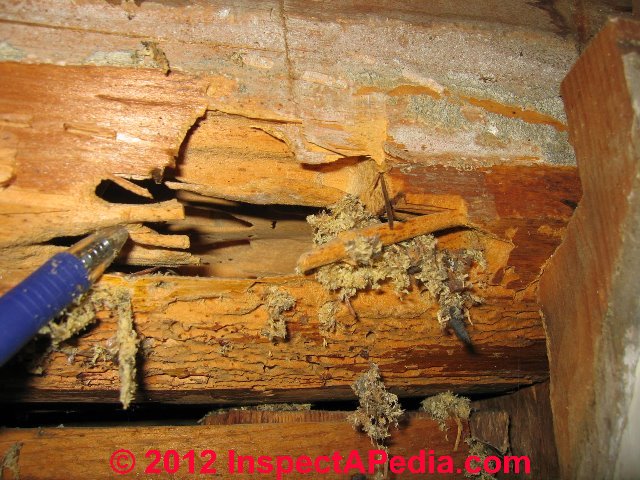 This page is the top level of our complete guide to insect problems found on or in buildings.
This page is the top level of our complete guide to insect problems found on or in buildings.
Here we outline major topics of concern regarding insect infestation or insect damage and we link to more in-depth diagnosis and repair information.
Photo just above: carpenter ant damage at a wood beam and lots of carpenter ant frass. Carpenter ants follow the softwood in the beam or joist, producing fine wood grain "sawdust", sometimes, as in this photo, mixed with other debris.
[Click to enlarge any image]
Article Contents
- IDENTIFY the INSECT - How do I tell a carpenter ant from a termite from a carpenter bee from a powder post beetle?
- DISTINGUISH INSECT DAMAGE from ROT - How do we recognize damage from wood destroying insects, mold, or rot on or in buildings?
- DISTINGUISH TYPES of INSECT DAMAGE - How do we determine the difference in damage from carpenter ant, carpenter bee, powder post beetle, and termite in buildings? - comparison photos & text
- DOG or OTHER PET BITING / CHEWING DAMAGE vs INSECT DAMAGE
- TERMITES vs CARPENTER ANTS - How do we tell the difference?
How do I Tell a Carpenter Ant from a Termite from a Carpenter Bee from a Powder Post Beetle?
If we do see insects in or on the building, it's pretty easy to tell CARPENTER ANTS (stomping around boldly in view, often near water or a sink or tub drain indoors) from a TERMITES (rarely in view unless swarming, but may fall out of a disturbed mud tube).
If you want a single rule, ants have a segmented body with a very very narrow waist (below left) while termites look more wormlike in their body (below right).
CARPENTER BEES look like a big slow-moving non-aggressive bumble bee. A female carpenter bee is shown in our third photograph.
You won't normally be able to see POWDER POST BEETLES (but they're not bad looking) you'll just see their dust and damage.
Above we illustrate carpenter ants including swarming winged carpenter ants, and
below a termite (sketch)
and a carpenter bee.
Common flies such as cluster flies are illustrated separately
at FLIES, MOSQUITOES REMOVE or REPEL.
How To Distinguish Among Damage from Wood Destroying Insects, Mold, or Rot on or in Buildings?
The first course in recognition of types of insect activity in or on a building is often the observation of the actual damage to wood materials in the structures. That's because depending on the type of insect, season, temperature, and other conditions we won't always see the wood destroying insects themselves.
Insect Damage Photos
Above you can see typical powder post beetle or old house borer damage to a wood joist or beam. And below you may notice the characteristic mud tubes we associate with termite damage.
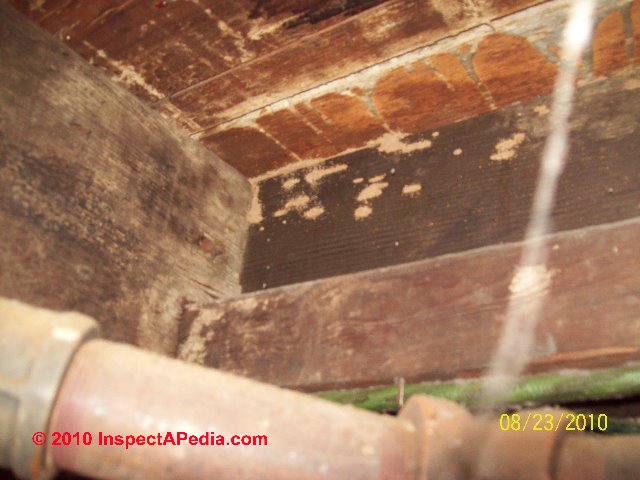
Below our photos illustrate typical carpenter ant damage (notice the large tunnels following the softwood and the fluffy carpenter ant frass)
and termite damage below (notice the presence of sandy mud and mud tubes throughout the damaged wood)
Also see COMPARE TERMITE DAMAGE to POWDER POST BEETLE
Wood Rot Identification Photos - "Brown Rot"
Below our photos illustrate typical wood rot.
All wood rot is caused by wood decaying fungi, typically basidiomycetes, some assisted by certain bacteria.
Watch out: you may find wood rot and insect damage together in a structure. But they are visually distinct.
See details at ROT TYPES, BROWN SOFT WHITE
Photos Assist in Telling the Difference Between Insect Damage & Wood Rot
Wood rot (above) tends to show breaks in the wood grain across the grain and in more or less rectangular forms.
Insect damage involves holes penetrating the wood and removal of the softer summer wood, tending to leave latewood or winter-wood behind to form walls and galleys (below right where my pen points to remaining hardwood).

Watch out: because moisture is involved in most wood destroying insect infestations (excepting drywood termites), you may find multiple sources of wood damage all together: wood rot along with termite or carpenter ant damage. (Carpenter bees prefer more dry wood and burrow right through both winter and summer wood in a board).
Can you tell from these photographs if this is mold or "dry rot"? Our surveyor says the beam needs to be replaced.
I have found your website most useful, and am emailing to ask your opinion (just from photos as am in the UK) with regards to suspect material on a timber beam. I appreciate you charge for consultations and I am happy to make a donation to your website if helpful.
I like in a top floor apartment in an 1850s terrace brick property in London. We had a leak in the Spring in the roof which damaged the front wall.
There are some exposed beams (although covered in plaster), part of the plaster was damaged exposing the beams and I partially painted the gap 3 months ago, a few days ago I noticed odd black stains with black looking hairs sticking out of it (see photos).
For photos on your website it looks like brown mold (but more black in colour), our surveyor is assuming it is dry rot and the beam needs to be replaced.
While it is hard for you to judge from photos, in your personal opinion what do think it is? Thanks so much for your help - J.G. 1/4/2014, London
Moderator (DF) Reply: rot or insect damage at a beam connection can be serious - very limited view
A competent onsite inspection by an expert usually finds additional clues that would permit a more accurate, complete, and authoritative answer than we can give by email alone.
For example, to assess the scope of damage in the building you are describing one would want to trace the location(s) and extent of leaks and to perform appropriate probing tests
to assess the depth & extent of actual structural damage to the beams involved.
While manual probing is usually sufficient, there are also more sophisticated tools available
That said I offer these comments:
From your photograph there is no doubt that there has been protracted leakage as the fungal growth that I see involve mycelia or "root-hair" -like structures characteristic of wood destroying fungi on wet wood.
While mold growth can appear quite rapidly, when I see extended mycelial growth along with cracked wood characteristic of brown rot fungi it is reasonable to infer that the leakage in that area has been going on for some time.
At above left we see fungal mycelia on what looks like the back-side of a fragment of drywall.
At above right we see the same mycelia on the side of what is probably a wood beam - indicated in your first photo above.
We also see "cracking" in the wood characteristic of wood rot, typically caused by a wood-rotting fungus in the Basidiomycete family but possibly involving other fungal genera/species such as Stemonitis sp. that I often find in buildings.
I'd need to see the fungus under the microscope to identify it - a step that is not necessary to decide on the need for structural repair except where
MERULIPORIA FUNGUS DAMAGE is involved. As that fungus is a characteristic yellow-gold, I don't see evidence of it in your photographs.
"Dry rot" does not really mean that rot occurred with no moisture present, so use of the term can be misleading.
What we cannot assess from your photographs is the depth and extent of rot and thus the actual need for replacement of the structural members. Especially in older buildings where the depth of rot into large structural members is shallow, for example an inch or less in a 8x12 beam, generally experts will fix the leak and leave the beam in service.
Depending on the structure type, and with the caveat that I am not a structural engineer nor do I have the benefit of onsite view and exploration of your particular building, I caution that there can be special cases where structural repair could be more urgent.
For example, if the ends of wood beams set into a masonry structural wall are deteriorated, and particularly where angular fire cuts were made in the wood beam ends, should the beam end become rot deteriorated there could be a risk of structural collapse.
In sum, from the very limited visual access seen just in your photos, but noting the apparent age of leakage and evidence of wood rot, a more thorough investigation is needed to determine if structural repair is needed at all (other than leak repairs), and attention needs to be given to the collapse risk points and structural connections in the building.
Beware of the "OPM" problem - a consultant who spends other people's money to reduce his or her own risk beyond that justified by the actual site conditions.
Beware of the opposite concern - a consultant whose work is superficial and inadequate and who fails to adequately identify and assess actual risk of serious structural damage or hazards.
Reader follow-up:
Many thanks for your detailed and quick reply, it is immensely helpful and really appreciated.
We have our original structural surveyor (from when we bought the property) returning next week but I note your comments re OPM...
as his instinctive reaction from just looking at the photo was that it needs replacing with a steel beam.
We will get some more expert assessments on site so we can have a full view of what to do. I will keep you informed of our progress, - J.G. 1/4/2014
DF Reply:
The case you have described, of water intrusion detected at one end of a large wood timber in an older London home, is perhaps a perfect test case for Probett's approach to wood timber strength assessment described in the citation I include below
Before tearing out an existing structural wood beam for replacement with a steel I-beam as your surveyor (in my opinion a bit too glibly) recommended, it would make sense to explore further the condition of the beam and its connections.
As my earlier email explained, in a large wood timber, a modest depth of surface rot damage may not be at all enough to merit timber replacement.
As Mr. Probett's equipment and a knowledgeable user are probably not available in London, you may be reduced to a more traditional but still reasonable timber assessment approach that includes
- removal of enough finish materials to form a confident opinion of the location(s) and extent(s) of and history of leakage that affected the beam in question .
- a visual inspection to find water or rot damaged wood
- mechanical probing to explore the depth of that damage
- a thoughtful assessment of extent of timber damage and thus compromise of its strength compared with the design loads involved
- careful attention in particular to points of connection, as for example in the case you have provided, the detected leak is at one end of a large beam; even if the overall beam is un-damaged, a failure at the connection point could be catastrophic.
- an interior inspection of the building finished-surfaces for evidence of leakage or movement (stains, cracked, dislocated drywall or plaster, wall-floor separation, etc)
- an exterior inspection of the building to identify its leak points and leak history, with an eye to identifying other areas where there may be un-discovered leakage, rot, and structural damage that need to be investigated.
My concern in writing this follow-up note is to be sure to point out that on a building built in the 1850's there will certainly have been leaks through its lifetime; depending on leak location, duration, severity, building materials, interior finishing, building occupancy, building maintenance level and similar variables, such leaks can go un-recognized for a long time, possibly allowing damage to be significant. On the other hand, and where my comments began, superficial damage is likely not to justify costly repairs.
Because this case is a fit application for methods he is developing, I have referred Paul Probett to our public discussion at https://InspectAPedia.com/structure/Structural_Damage_Probing.php
If you agree I'd like to also send him a copy of our correspondence. See
- Paul S. E. Probett, Clinton S. Craig, Blake J. Probett, "IN SITU STRUCTURAL TIMBER STRENGTH MEASUREMENT ADVANCES USING QUALITATIVE RESISTOGRAPHY AND QUANTITIVE RESISTO-FRACTOMETRY" [USFPL paper, 730KB], Paul S. E. Probett MIFPI, AsocRICS, MBOINZ, MNZIBS, NZCB. Clinton S. Craig Blake J. Probett INCODO Ltd, Tauranga, New Zealand, mail2us@incodo.co.nz, 18th International Nondestructive Testing and Evaluation of Wood Symposium - Madison, WI Sept 2013, http://www.forestprod.org/symposium2013/
discussed in our article series WOOD STRUCTURE ASSESSMENTReader follow-up:
Daniel this is incredibly helpful, it is really good to get an understanding of all the various things to consider and from an unbiased source, it seems clear that each situation is different to the last and there is no 'boiler plate' solution that should be instantly applied.
While I have no expert knowledge of any of this, my instinct was that every scenario should be considered before the most invasive option of a steel beam, particularly from the structural reason that we are in an old property which has a tendency to move or expand a bit (unfortunately a curse of Islington in London all being built on clay) and hence the sheer weight of a steel beam might present its own problems on a house designed for timber and bricks, however as you rightly mentioned - surveyors, in the uk at least, want to present the best option to cover their personal liability regardless of cost
I certainly come with the view that whatever is necessary should be done (as the consequences of not doing so could be fatal) but the right solution should be found Please feel free to pass on our correspondence to Mr Probett - J.G. 1/5/2014
Difference Between Carpenter Ant Damage, Carpenter Bee Damage, Powder Post Beetle Damage & Termite Damage in Buildings?
For this discussion please also review the example photographs we provide above showing all of these insect types and what their damaged wood looks like.
Also see the individual articles for each insect or topic. Carpenter ants, carpenter bees, termites, even powder post beetles or old house borers all provide visible indications of insect activity such as entry or exit holes, mud tubes, or the presence of the insects themselves.
Carpenter ant damaged wood
will show cleanly excavated wood passages - the frass is brought outside of the area of excavation.
And seasonally you'll find carpenter ants or carpenter ant bodies.
Details are at CARPENTER ANTS
Carpenter bee damaged wood
will be on the exterior of the building, typically well above ground, in wood trim, siding, decks, etc.
You will observe 5/16" to 1/2" diameter round holes, usually penetrating the edges of boards and when the bees are active you'll find coarse fresh sawdust below the working opening.
Details are at CARPENTER BEES
Powder post beetle damaged wood
will show multiple tiny holes, about 1/8" in diameter, leaving the outermost surface of the wood otherwise intact.
Probing you will find powdery sawdust and damaged wood just below this skin.
The older the powder post beetle (or old house borer beetle) damage is, the deeper into the wood the damage will extend.
For this reason, strategic probing is important to assess the depth of damage to the wood and thus to the wood structure.
When powder post beetles are active you may see light dusting of fine wood powder around some of these holes as well as on surfaces below.
Details are at POWDER POST BEETLES
Also see COMPARE TERMITE DAMAGE to POWDER POST BEETLETermite damaged wood
typically will include the presence of visible mud tubes and mud-like substance inside the excavated wood galleys.
Because termites need to protect themselves from drying out and light they are not found on the exterior of wood under termite attack.
It's rare to see an active termite unless you disturb (break apart) a mud tube while it's in use - in that case you'll see pale termites fall out. You will see termites if they are swarming however. (Watch out for "winged ants" that are not).
 Details are at TERMITES
Details are at TERMITES
Wood rot itself
does not produce insect entry/exit holes nor mud tubes, but of course both wood rot and insect damage are often found together and may even be found within the same wood member or board.
Mold is a very broad kingdom of fungi, among which some molds, particularly the basidiomycetes are wood rotters.
So not all mold causes wood rot, but basically all wood rot in homes is thanks to one or more mold genera/species. (With some help from bacteria).
Details are at
Watch out: conditions that encourage mold growth in buildings, particularly chronic leaks or water entry, are an invitation to wood destroying insects as well.
How to Distinguish Dog Chewing or Biting Damage from Insect Damage to Wood
What caused this damage to wood in my home? Insects?
I am trying to figure out what caused the damage in the attached photographs.
Location is Columbia County, NY. There is no visible sawdust or debris, and I have not seen any insects. Any help would be appreciated. - Anonymous by private email 2018/10/17
Reply: bad dog! chewed wood trim
Having seen damage done by nervous or irritated dogs who attack building components, trim, even drywall indoors and, of course, furniture, my bet is that a dog is or was at your property.
Reasons that this is animal damage not insect damage.
- There is no sawdust or frass
- Some of the bites or gouges continue as a scrape across the wood surface
- The edge of the wood trim has been ripped away showing torn wood grains - this is not characteristic of insect attack.
Bad dog!
The gouges into the wood are shaped as if penetrated by a roughly V-shaped or spike-shaped (sharp) tooth rather than coming from tunneling or wood-destroying insects. You will see other photos of typical insect damage of all sorts in this article series.
Other examples of animal biting, chewing, or digging that causes damage at properties as well as animal allergens, urine removal, and odors are discussed at
How to Recognize Carpenter Ants or Termites or Both in a Window Frame
 Can you
tell me what this damage to my house was caused by?
Can you
tell me what this damage to my house was caused by?
Can you tell me what this damage to my house was caused by? No insects visible and I have not found any similar damage elsewhere on the exterior of the house.
The moisture is from spraying dilute fipronil, there is no direct exposure to rain. Thanks for any help. - J.H., Athens GA, USA 12 Sept 2015
[Click to enlarge any image]
Reply:
That looks like termite mud tubes to me; It's unusual to find termite damage in a movable window sash.
I would be very careful to have a very thorough pest inspection: I suspect that if there is wood destroying insect damage in a window sash it is also more extensive in other structural features such as wall framing.
Dig out some of the "sawdust" shown in the lower part of your photo.
If it's muddy and granular that suggests a termite mud tube. If the "sawdust" is carpenter ant frass it will be light, loose, fluffy material.
Reader follow-up:
Thank you for your help Daniel!
I will probably get a professional inspection. Actually it is a fixed window not a movable sash.
Reply:
Keep me posted on what you're told, JH
If there is access to the house from below look in that area for more mud tubes and thus termites.
See TERMITE DAMAGE INSPECTION
and also
see CARPENTER ANTS
For examples of both of these insects and their damage, sawdust or frass, detection, damage inspection, treatment or control.
Reader follow-up:
It looks like these may be carpenter ants rather than termites. I dug into the wood a bit and pulled out some dead 'animals'... this photo
 This photo may show a couple of different individuals, but you can see identifying characteristics of carpenter ants, ... They also appear to be have been active near my roof skylight which has (or had) a slight leak and from which I have sometimes seen sawdust drifting down.
This photo may show a couple of different individuals, but you can see identifying characteristics of carpenter ants, ... They also appear to be have been active near my roof skylight which has (or had) a slight leak and from which I have sometimes seen sawdust drifting down.
Apparently they are not as destructive as termites.
I have some Fipronil which I bought to treat dog for fleas, but is sold for termite control. I will probably spray some cautiously to discourage these beasts. Feel free to use my photos or info on your website.
Reply: these are carpenter ants
Yes, your photo shows carpenter ants, but I thought I saw what might be mud tubes in the bottom of your window frame damage photo. If so there were termites.
Both of these insects can do tremendous damage to wood structures if left unattended. A layperson's description of a difference between carpenter ants and termites (among many) is that
- Carpenter ants
chew holes following the softwood in the wood they invade but they carry the sawdust to an exit point and toss it away; you'll often see piles of sawdust (light colored if recent) below an area of carpenter ant infestation.
Carpenter ants are big brazen fellows, they look like (and are) big black ants and you'll find them stomping around when weather and temperature conditions are favorable (to them).
See CARPENTER ANTS- Termites
also chew passages along the softwood in the wood that they invade, but they don't toss their chewed sawdust outside. Rather they use it, along with termite-spit to produce mud-tubes that run either inside or outside of the surfaces of the wood or other structure that they are invading.
Termites are shy pale little devils that you will never see unless you break open one of their mud tubes while they are therein.
See TERMITE IDENTIFICATION & CONTROLIn old wood damage we sometimes find both insects have attacked the wood.
DIY Treatment for Carpenter Ants or Termites using Fipronil and Pet Flea Powder
About using Fipronil to treat your carpenter ants or termites or both,
Fipronil is a broad use insecticide that belongs to the phenylpyrazole chemical family. Fipronil is used to control ants, beetles, cockroaches, fleas, ticks, termites, mole crickets, thrips, rootworms, weevils, and other insects. ...
Fipronil is used in a wide variety of pesticide products, including granular products for grass, gel baits, spot-on pet care products, liquid termite control products, and products for agriculture.
There are more than 50 registered products that contain fipronil. - NPIC, retrieved 26 Sept 2015 original source: http://npic.orst.edu/factsheets/fipronil.pdf
Watch out: sprinkling a pet flea powder, even though it contains fipronil, may not be effective for treating termites as in a pet use formulation it's in a vehicle and at a concentration intended for safe use on animals.
More, you may fail to find the total extent of insect damage and/or may miss the proper locations of application. Also you're skipping treating the cause: leaks or moisture, that invited insects into the structure in the first place.
If you are confident that the total area of infestation is trivial you can try an insecticide combined with steps to stop the water problem; but watch out for the possibility of more extensive hidden damage. When I find termites or carpenter ants in a window sash I figure that there's a good chance their activity was much more widespread in the structure.
See AMATEUR TERMITE TREATMENT WARNINGS
How do We Evaluate the Extent of Insect or Rot Damage on or in Wood Structures? Structural Damage Assessment Procedure
Steps on how to conduct a thorough evaluation of the extent of structural damage to a building is now found
5 Basic Steps in Repair of Damage by Wood Destroying Insects
The general approach to repairing damage from wood destroying insects can now be found
at INSECT DAMAGE - WOOD REPAIR STEPS
Nine Approaches to Prevention of Wood Destroying Insect Damage
Strategies for the prevention of wood destroying insect damage can be found
Harmless Insect Activity: Bagworms, Insect Egg Cases & more
For more discussion about harmless insect activity that may result in cosmetic damage vs. structural damage
...
Reader Comments, Questions & Answers About The Article Above
Below you will find questions and answers previously posted on this page at its page bottom reader comment box.
Reader Q&A - also see RECOMMENDED ARTICLES & FAQs
What Florida insect damaged the paint layer of these old ceiling tiles?
What chewed the paper layer in a 50 year old manufactured home in Florida? It left fibers below and squarish frass. 2025-02-19 by private email.
Moderator reply:
I don't know. That's an interesting question.
Frankly it would be unusual for insects to attack paint. I have found insect damage to fiberboard products though that itself isn't common.
But all of the damage in your photo appears to be just to the paint layer. Insects may chew through wood material and that might disturb the painted surface but I'd expect to see some other evidence of insect activity on these fiberboard ceiling panels or nearby in the building.
To identify the insect causing damage at a building, normally we would look for insect bodies and parts that would let us be more confident about identifying the insect. We would explore the area above that damage to see what else has happened in that space.
If there is an attic or roof space you need to get in there to inspect more carefully.
While there are not obvious water stains in your photos, I'd look for moisture or leaks to estimate the possibility of other causes.
Is this the only evidence of such damage or possible insect activity in your building?
On 2024-04-20 by Rick James - Spots wipe of with vinegar, red-brown-gritty = insect?
I recently have had about ten of these splotches appear all throughout my office, the floor is laminate man-made fake wood , we recently had a carpet beetle and possibly powderpost beetle problem a month ago...
these spots havent spread any more than what is here. the spots easily wipe away with vinegar, they are red-brownish rust colored with a gritty appearance and texture. any ideas ? From Mid-North Carolina.
On 2024-04-20 by InspectApedia Publisher
@Rick James,
That could be eggs from an insect but it's not something that I recognize. I'll do a little research to see if I can find it elsewhere.
Is there a high level of moisture or is it wet in the area where the spots are appearing?
If so it could be a fungus such as Stemonitis, a brown, hairy mold that we describe it this website.
See
https://inspectapedia.com/mold/Brown_Hairy_Mold.phpFollowup by Rick James
@InspectApedia Publisher, the room had a large amount of cans and old trash on the floors for a long time. but the spots didnt show up until after the room was cleaned, and the spots appeared at the same time the room had a large amount of white Larvae on the floor and Carpet Beetles all around.
But im pretty sure C. Beetles dont make clusters like this. i noticed the varied beetles building mud like bindings on real wood surfaces in the bathroom as well. any thoughts on anything here ?
Very confused and terriblly afraid of bugs. might be dealing with a bedbug infestation now too, could this be related ?
Reply by InspectApedia Publisher
@Rick James,
Those clusters of fuzzy stuff are not bedbugs.
In your second or right-hand image, I agree that we see some tiny white spots but I can't make out what they are.
If you can get a really sharp photo from a bit closer I might be more confident about what we're seeing.
Be sure to check the photos at the Stemonitis page that I suggested and to compare what you're seeing with that.Other possible types of fungus that look like that include some species of Periconia and also Pseudothecia - see this paper and its photos on plant diseases from Oklahoma State University
https://extension.okstate.edu/e-pest-alerts/site-files/documents/2003/wheat-disease-update-november-11-2003.pdf that mentions Pseudothecia - that you'd find on the leaves of wheat plants. I'd not expect that on flooring in a building but you could have something similar.IF it's an insect species it could be something like Pteroxanium kelloggi.
Also see
On 2024-04-21 by Rick James - Pteroxanium kelloggi Possibly also the Red Mold/Stem.
@InspectApedia Publisher, While it says online that the Pteroxanium kelloggi is native to European/Eastern Countries, it says it feeds on Rhododendron Which is Rampant here in NC. also, the white spots on the photo are because of the flash of the camera so they should be ignored.
I still cant make a complete diagnosis as the patches havent spread since i neutralized them. Possibly also the Red Mold/Stem.
On 2024-04-21 by InspectApedia Publisher
@Rick James,
It may be helpful to understand that it'd be unlikely that a fungus or mold that grows only on living plants would be found on the surface of an interior wood floor inside a building.On 2024-04-21 by Rick James
@InspectApedia Publisher, Yes, possibly the Stemonitis still or unknown insect, i am still searching as im not convinced its 100% either or. if more shows up i will try to get a live sample and grow it out. these may be too damaged to get a proper ID
On 2023-08-30 by Wendy - little black bugs in my house
I have found a few of these little black bugs in my house recently and now there is what appears to be damage to my bathroom baseboards. Is this a wood boring beetle?
On 2023-08-31 by InspectApedia-911 (mod)
@Wendy,
I'm so sorry but when I tried to zoom in on your photo for a look all I can see is a blurry oblong shape. I don't know what the scale is and I can't see any features so I don't know what that is.
It's not likely to be a powder post beetle however as you can see from the tiny diameter of the holes in the photos above on this page that those are extremely small.
If you can say more about and show more clearly what the wood damage is that you have seen I may be able to come in further or even to identify the type or cause of damage.
On 2023-09-02 by Wendy
@InspectApedia-911, thank you for your response. I am attaching a picture of what I have seen in a windowsill.
I have also seen carpenter ants in the yard and a few flying carpenter ants. Is this something they would do?
On 2023-09-02 by InspectApedia Publisher
@Wendy,
that looks like old damage to a window sash or frame.
On 2023-08-19 by Elizabeth Renee Minck
Can you tell me what kind of bug these are?
On 2023-08-19 by InspectApedia Publisher - ant, probably a carpenter ant
@Elizabeth Renee Minck,
I don't have a ruler for scale, but that's certainly an ant, probably a carpenter ant. Give us the age and location and type of building and location in the building where the ant was found.
On 2023-04-12 by Chuck
Hello, I inspected a detached garage today that had visible wood damage from the outside. The owner let me open the damaged area by pushing it in (and it easily crumbled) to see if any insects were visible inside.
When I opened the area I saw the damaged wood (see attached picture) with a number of these little round oval dark brown to blackish things inside (see circled area on picture). I saw no visible pests but a number of these oval things. You can tell some sort of wood destroying insect has been damaging the wood.
The owner said he started noticing the damaged wood for approx 6 months but just now decided to have it looked at. He said the damage has grown significantly in that time and is continuing to grow. I ruled out subterranean termites due to the holes being too large. Any help identifying appreciated.
On 2023-04-12 by InspectApedia Publisher - size of holes indicate carpenter ants
@Chuck,
That't looks like a combination of brown rot - cracked soft wood with spllit lines both along and across the wood grain, along with fine sawdust that could be carpenter ant frass or, less likely as I don't see mud, termited damage.
Please see our complete reply now moved to
On 2022-10-15 by oboy
What Does this looks like? Bug ID
On 2022-10-15 by InspectApedia (Editor) - old insect damage to a tree before cut into lumber
@oboy,
Looks like carpenter ant damage (or another insect) probably from before the wood was milled.Please see our complete reply now moved to
...
Continue reading at CARPENTER ANTS or select a topic from the closely-related articles below, or see the complete ARTICLE INDEX.
Or see INSECT INFESTATION / DAMAGE FAQs - questions & replies posted originally on this page.
Or see these
Recommended Articles
- INSECT INFESTATION / DAMAGE - home
- BEDBUG PESTS
- CARPENTER ANTS
- CARPENTER BEES
- FLIES, MOSQUITOES REMOVE or REPEL
- HONEY BEES in BUILDING WALLS
- INSECT DAMAGE PREVENTION
- INSECT DAMAGE - WOOD REPAIR STEPS
- INSECTS & FOAM INSULATION
- MERULIPORIA FUNGUS DAMAGE
- MOLD: A COMPLETE GUIDE TO MOLD
- MOTHS, MOTHBALL ODORS
- PESTICIDE EXPOSURE HAZARDS
- POWDER POST BEETLES
- TERMITE INSPECTION & DAMAGE ASSESSMENT
- TERMITE IDENTIFICATION & CONTROL
Suggested citation for this web page
INSECT INFESTATION / DAMAGE at InspectApedia.com - online encyclopedia of building & environmental inspection, testing, diagnosis, repair, & problem prevention advice.
Or see this
INDEX to RELATED ARTICLES: ARTICLE INDEX to INSECT DAMAGE
Or use the SEARCH BOX found below to Ask a Question or Search InspectApedia
Ask a Question or Search InspectApedia
Try the search box just below, or if you prefer, post a question or comment in the Comments box below and we will respond promptly.
Search the InspectApedia website
Note: appearance of your Comment below may be delayed: if your comment contains an image, photograph, web link, or text that looks to the software as if it might be a web link, your posting will appear after it has been approved by a moderator. Apologies for the delay.
Only one image can be added per comment but you can post as many comments, and therefore images, as you like.
You will not receive a notification when a response to your question has been posted.
Please bookmark this page to make it easy for you to check back for our response.
IF above you see "Comment Form is loading comments..." then COMMENT BOX - countable.ca / bawkbox.com IS NOT WORKING.
In any case you are welcome to send an email directly to us at InspectApedia.com at editor@inspectApedia.com
We'll reply to you directly. Please help us help you by noting, in your email, the URL of the InspectApedia page where you wanted to comment.
Citations & References
In addition to any citations in the article above, a full list is available on request.
- Steve Bliss's Building Advisor at buildingadvisor.com helps homeowners & contractors plan & complete successful building & remodeling projects: buying land, site work, building design, cost estimating, materials & components, & project management through complete construction. Email: info@buildingadvisor.com
- [3] Jeffrey Hahn, Colleen Cannon, and Mark Ascerno, "Carpenter Ants", University of Minnesota Extension, retrieved 9/19/2012, original source: http://www.extension.umn.edu/distribution/housingandclothing/dk1015.html, copy on file as [Carpenter_Ants_UMinn.pdf]
- [4] Paul Probett, Clinton Craig, Blake Probett, "An Introduction to Micro-Drilling Technology for N. Z. Structural Timber Assessment", Incodo Ltd, 4/511 Cameron Rd, Tauranga NZ, article adapted by InspectAPedia with permission, August 2012. Contact the authors by Email: Paul Probett, mail2us@incodo.co.nz , Tel: 027 28 000 36 (Mobile) Website: https://www.incodo.co.nz/ [Copy of this article on file as Microdrilling_Assessment_Incodo.pdf]
Quoting from the Incodo website the company describes its services:
- Incodo Forensic Building Pathology:
The Forensic Building Pathology division provides evidence in report form to government agencies, consultancy firms, lawyers and others, when truly independent analysis based on comprehensive testing is required. Incodo arguably has the largest, most up-to-date and comprehensive range of building investigation equipment available and has developed unique methodologies particularly in the field of non-destructive testing for leaking structures. - Incodo In situ Timber Assessment:
The in-situ Timber Assessment division provides a service whereby technicians use state-of-the-art timber resistance drill technology to profile variations in timber density associated with timber decay.
The work is done on site and the results are instant.
This technology is objective and evidential in nature and provides assessment as to whether wood is significantly decayed, suspect or suitable for retention. The technology has particular application in locating and assessing hidden decay.
- Incodo Forensic Building Pathology:
- [5] Thomas Tannert, Andreas Muller, Mareike Vogel, "Applications and limitations of NDT: a timber bridge case study", NDTCE’09, Non-Destructive Testing in Civil Engineering
Nantes, France, June 30th – July 3rd, 2009, web search 8/3/2012, original source: http://www.ndt.net/article/ndtce2009/papers/144.pdf [copy on file as Tannert_Timber_Test_144.pdf]
Abstract
The applications and limitations of different non-destructive and semi-destructive techniques to evaluate the structural integrity of timber members in a pedestrian bridge are presented as a case study. Sophisticated assessment tools are required to detect hidden damages in timber structures: for example stress-wave techniques are used to evaluate the modulus of elasticity of bending members and resistance to drilling is used to gain knowledge of areas of changed density due to insect or moisture induced damages.
Reliably relating the gathered data to the structural integrity of the structure is a complex issue.
Bending members and connection details of a decommissioned timber bridge were evaluated using non destructive assessment tools. Eventually these parts were tested destructively to assess their remaining modulus of elasticity and load bearing capacity
. The need for improvements in the current practice is highlighted by comparing the results from the non-destructive, semidestructive and destructive tests. - [6] David Grudzinski, Advantage Home Inspections, ASHI cert # 249089, HUD cert# H-145, is a professional home inspector who contributes on various topics including structural matters. Mr. Grudzinski, Cranston RI serving both Rhode Island and Eastern Connecticut can be reached at 401-935-6547 fax- 401-490-0607 or by email to Davidgrudzinski@aol.com. Mr. Grudzinski is a regular contributor to InspectAPedia.com - see DECK FLASHING LEAKS, ROT Case Study, and BASEMENT WATER MOLD IMPACT and VERMICULITE INSULATION for examples.
- [7] Mara and Andy Gieseke, Tucson AZ, are contributors to InspectAPedia.com including photographs used at SIDING EIFS & STUCCO, CONTROL JOINT CRACKS in CONCRETE and ROT, FUNGUS, TERMITES, and are family members of website publisher Daniel Friedman.
- [8] Desert Termites, Thomas W. Fuchs, Extension Entomologist, Darrell N. Ueckert, Texas Agricultural Experiment Station, and Bastiaan M. Drees, Extension Entomologist, Texas Agricultural Extension Service, Texas A&M University System, web search 09/13/2010, original source: http://insects.tamu.edu/extension/bulletins/uc/uc-016.html
- [9] Termites - Greenhouse Gases, U.S. EPA, Environmental Protection Agency. Web search 09/11/2010, original source: http://www.epa.gov/ttn/chief/ap42/ch14/final/c14s02.pdf Quoting an interesting passage from this brief document:
Termites inhabit many different ecological regions, but they are concentrated primarily in tropical grasslands and forests. Symbiotic micro-organisms in the digestive tracts of termites (flagellate protozoa in lower termites and bacteria in higher termites) produce methane (CH4). Estimates of the contribution to the global budget of CH4 from termites vary widely, from negligible up to 15 percent. - [10] Truly Nolen Pest Control, Tel: 866-221-4765, is a national franchise of pest control operators in the U.S. Quoting from the company's website:
Truly Nolen [has] over 80 offices located in Arizona, California, Florida, Nevada, New Mexico, Texas and Utah. The company services more than 150,000 customers and employs about 1,100 partners, with almost 50 percent service technicians. Domestic franchises are offered throughout the United States. International franchises are also established in over 30 countries. - [11] U.S. EPA. Prevention, Pesticides, and Toxic Substances. 1997. Re registration eligibility decision: Diflubenzuron. Pp. 17, 46. www.epa.gov/ pesticides.
- [12] U.S. EPA. Office of Prevention, Pesticides and Toxic Substances. 1994. Pesticide fact sheet: Hexaflumuron. Washington, D.C.
- [13] U.S. EPA. Office of Pesticide Programs. 2003.
Pesticide ecotoxicity database. Unpublished database.
U.S. EPA. Prevention, Pesticides, and Toxic Substances. 1998. Re registration eligibility decision: Hydramethylnon. Pp. 16-18, 43. www.epa.gov/pesticides. - [14] U.S. EPA. Prevention, Pesticides and Toxic Substances. Undated. New chemical New chemical fact sheet: Noviflumuron. Washington, D.C.
- [15] "Protecting Your Home from Subterranean Termite Damage", Journal of Pesticide Reform, Fall 2004, V 24 No. 3, - 6-7, Northwest Coalition for Alternatives to Pesticides/NCAP, POB 1393, Eugene OR, 97440 541-344-5044 www.pesticide.org: Web search 09/11/2010: http://www.hipspro.com/pubs/subterraneantermites.pdf
This document discusses alternatives for termite protection including reducing the attractiveness of the structure to termites (get wood away from the building, fix leaks), use of 16-grit sand (diameter 0.06 - 0.1 in) as a termite barrier 18" wide x 3" deep in crawl areas, or stainless steel mesh for the same purpose under foundations and slabs, boric acid, Diflubenzuron (insect growth regulator, risk genetic damage, EPA classed as carcinogen), Hexaflumuron (insect growth regulator, EPA didn't ID health concerns, waived some testing, partly because of anticipated very low risk of human exposure), Hydramethylnon (stomach toxicant, EPA: Carcinogen, highly toxic to fish), Noviflumuron (chemically similar to hexaflumuron), can cause anemia, EPA didn't ID other health hazards, some testing requirements waived, moderately toxic to fish). - [16] Friedman, Daniel, HOUSE EATING FUNGUS [Web article] Meruliporia incrassata (also called "Poria" the house eating fungus) in the U.S. or Serpula lacrymans in Europe) can cause severe structural damage.
Evidence of hidden "poria" may be found by expert inspection methods which include tracing sources and paths of probable Building leaks and moisture traps. Further, careful indoor particle sampling methods can often permit the presence of this mold to be identified in the laboratory. - [17] Pesticides Contaminate House [PDF] - news article about improperly applied pesticide chemicals and building contamination
- [18] Termite Damage Case Study#1 - exterior clues predicted insect damage; interior access was limited but certain clear clues led right to the damage as well as an attempted cover-up of termite damage below a "repaired" wooden floor. The real evidence was in the driveway. [in process]
- [19] Termite Damage Case Study#2 - very limited visual access inside a building made this inspection for structural damage tough. Outside conditions suggested a risk of water entry and insect attack. Inside the house had mysteriously sloping floors - sloping in every direction. There were few indications of ongoing building movement to explain the sloping. Perseverance led to finding severe termite damage at the building sills. [in process]
- [20] Wikipedia Web: https://www.wikipedia.org/ provided background information about some topics discussed at this website provided this citation is also found in the same article along with a " retrieved on" date. NOTE: because Wikipedia entries are fluid and can be amended in real time, we cite the retrieval date of Wikipedia citations and we do not assert that the information found there is necessarily authoritative.
Termites, Wikipedia web search 09/11/2010, original source: http://en.wikipedia.org/wiki/Termite provided some information about termite size. - [21] Hoadley, R. Bruce. Understanding Wood, 1980, Newton, CT: Taunton Press.
- [22] Panshin, A. J. and Carl de Zeeuw. Textbook of Wood Technology, 1980, NY: McGraw-Hill.
- [23] Story, Keith O. Approaches to Pest Management in Museums, 1985, Washington D.C.: Smithsonian Institution.
- [24] University of Wisconsin Dept. of Entymology, "Insect ID - wood attacking insects", retrieved 10/25/2012, original source http://www.entomology.wisc.edu/insectid/wood-attk.php
- In addition to citations & references found in this article, see the research citations given at the end of the related articles found at our suggested
CONTINUE READING or RECOMMENDED ARTICLES.
- Carson, Dunlop & Associates Ltd., 120 Carlton Street Suite 407, Toronto ON M5A 4K2. Tel: (416) 964-9415 1-800-268-7070 Email: info@carsondunlop.com. Alan Carson is a past president of ASHI, the American Society of Home Inspectors.
Thanks to Alan Carson and Bob Dunlop, for permission for InspectAPedia to use text excerpts from The HOME REFERENCE BOOK - the Encyclopedia of Homes and to use illustrations from The ILLUSTRATED HOME .
Carson Dunlop Associates provides extensive home inspection education and report writing material. In gratitude we provide links to tsome Carson Dunlop Associates products and services.


